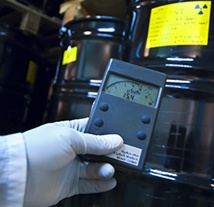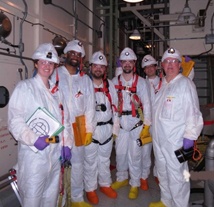Part 1 of 3 Part Series, By Amy Theis, Manger of Risk Managment Services, Fauske & Associates, LLC
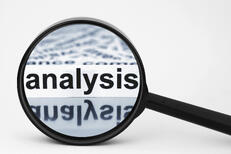 According to ABET (The Accreditation Board for Engineering and Technology lead by the American Institute of Chemical Engineers), the "Program Criteria for Chemical, Biochemical, Biomolecular, and Similarly Named Engineering Programs" curriculum must:
According to ABET (The Accreditation Board for Engineering and Technology lead by the American Institute of Chemical Engineers), the "Program Criteria for Chemical, Biochemical, Biomolecular, and Similarly Named Engineering Programs" curriculum must:
"...provide a thorough grounding in the basic sciences including chemistry, physics, and/or biology, with some content at an advanced level, as appropriate to the objectives of the program. The curriculum must include the engineering application of these basic sciences to the design, analysis, and control of chemical, physical, and/or biological processes, including the hazards associated with these processes." As such, it is important to be sure hazard identification is at the core of any safety program. This article is meant to provide steps for that identification as well as evaluations and testing methods.
1. A part of any Hazard Assessment Strategy should include:
-
Process and material characterization
-
Identify the process hazards/hazardous conditions
-
Understand the consquences
-
Reduce, eliminate, substitute, prevent or mitigate the hazard
-
Document, train and manage change
2. Screening for reactive chemical hazards must include the following questions:
-
Intentional chemistry?
-
Mixing/combining of different substances?
-
Physical processing of substances?
-
Heat generated?
-
Spontaneously combustible?
-
Peroxide forming?
-
Water reactive?
-
Oxidizer?
-
Self-reactive?
-
Incompatible materials?
3. Hazard identification must include all process safety information such as:
-
Materials
-
Potential chemical interactions
-
Chemistry for desired chemical reaction
-
Process variables/operating conditions
-
Temperature (desired reaction and possible side/decomposition reactions)
-
Pressure (gas and vapor)
-
Composition/recipe
-
pH
-
Identify upset conditions
4. All chemical reactivity hazards must next be identified:
-
Evaluate thermal stability
-
Raw materials, additives, catalysts, intermediates, product, waste streams
-
DSC screening
-
Reaction calorimetry (RC1, RC, Chemisens)
-
Material compatibility
-
Literature review (Bretherick’s, other)
-
Incident review
Name/Structure
Alkenes (R2C=CR2)
Alkynes/acetylenes (RC=CR)
Peroxides (ROOR/ROOH)
Organic sulfoxides (R2S=O)
Hydrazines (RNH-NH-R)
Diazo/Diazonium (RN=NR/RN=N+)
Azides (RN3)
Oxime (R2C=NOH)
Nitroso (R2C-N=O)
Isocyanate (RN=C=O)
Nitro (R3C-NO2)/n-Nitro (R2N-NO2)
Acyl nitrates (-O-NO2)
5. Next, is a thorough desktop screening and literature review including:
-
MSDS review – physical data, reactivity data, corrosivity data
-
Manufacturer technical information
-
Examine functional groups
-
Perform CHETAH estimations to determine hazard class
-
Material incompatibility – binary chemical interaction matrix
-
Previous incidents (plant, corporation, industry)
-
NOAA Chemical reactivity worksheet (Revised)
-
Bretherick’s, Handbook of Reactive Chemical Hazards
-
Sax, Dangerous Properties of Industrial Materials
-
U.S. CSB Investigation Reports
-
Thermal Safety of Chemical Processes (Stoessel)
-
Guidelines for Safe Storage and Handling of Reactive Materials (CCPS)
-
Designing and Operating Safe Chemical Reaction Processes (HSE)
-
NFPA 49, Hazardous Chemicals Data
-
Essential Practices of Managing Chemical Reactivity Hazards (CCPS)
-
Chemical Reaction Hazards, A Guide to Safety (IChemE)
-
WISERS US National Library of Medicine - on smart phones
6. Understand the chemistry for desired reactions including:
- Heat of reaction
- Adiabatic temperature rise
- Rate and quantity
- Heat generation
- Gas generation
- Identify accumulated reagent/heat
- Heat removal requirement
- Chemical incompatibility
- Thermal runaway reaction
- Thermal decomposition(s)
- Overpressurization
- Process upset due to a worst case scenario
- Hazard and Operability Study (HAZOP)
- What-if analysis
- Failure Modes and Effects Analysis (FMEA)
- Checklist analysis
- Fault tree analysis
- Batch sheet review (line by line review)
- Incorrect reactants or wrong order of addition
- Contamination
- Corrosion - unwanted catalytic effects
- Material compatibility
- Overcharge / undercharge catalyst
- Addition at wrong temperature
- Loss of cooling
- Inadvertent heating
- Loss of mixing / agitation
- Condenser failure
- Loss of vacuum
- Accumulation
- Mass-loaded upset
- Fire exposure
- Utility failure
- Testing should provide data required to define safe processing conditions
- Temperature, pressure, concentration, etc.
- Understand test results using plant scale heat loss conditions
- What processing conditions could lead to a problem?
- Can the problem be handled using existing safeguards ?
- Does the hazard need to be avoided using chemistry ?
- Can the consequences be mitigated?
- Know your corporate acceptable level of risk
- Perform adiabatic testing prior to scale-up
- (ARSST, ARC, VSP2, etc.)
- Maximum temperature rise of desired reaction
- Onset temperature of decomposition reaction
- Could onset temperature of decomposition be reached if process deviations occur
- Non-condensable gas - rate & quantity
- Heat generation – rate & quantity
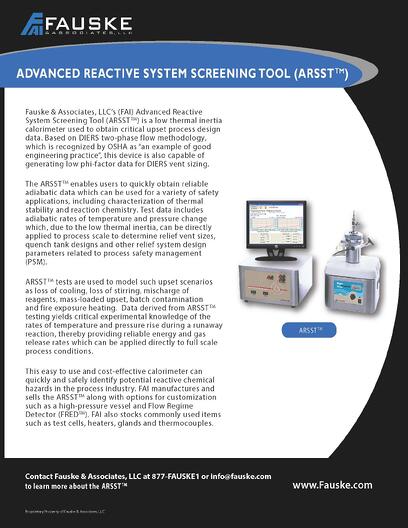
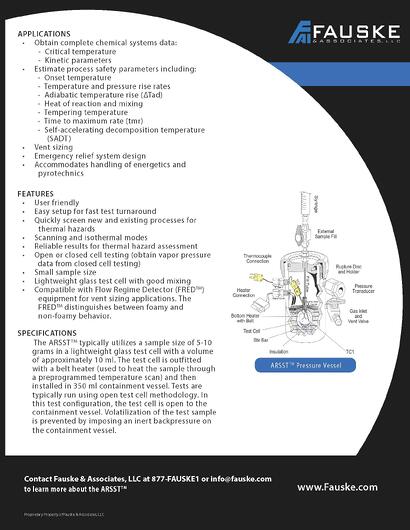
- Critical temperature (i.e. temperature of no return)
- Vessel charge amount
- Operating procedures
- Cooling requirements to prevent runaway
- Time to maximum rate
- Emergency relief system design (or other mitigation strategy)
- Emergency response procedures
13. Understand the Consequences:
- Can process be performed safely?
- Are risks too high?
- Vent size too large?
- Identify cause(s) of chemical reactivity
- Decide if and how the process can be changed to eliminate the adverse event(s)
- Verify the new process by retesting where needed
- Evaluate the need for safeguards
14. Identify the Risk:
- Risk = Severity x Probability
- Adiabatic data interpretation is IMPORTANT
- Determines the chemical reactivity risk
- Is there potential for this scenario to happen
- Is it tolerable for this scenario to happen
- If the risk cannot be tolerated, it needs to be controlled
- Inherently safer alternatives
- Passive controls
- Active controls
- Procedural controls
- Safe operating limits
- Mitigation techniques
16. Find the inherently safer alternatives:
- MINIMIZE: Reduce amount of hazardous material during storage and processing
- SUBSTITUTE: Use a less hazardous material
- Clean w/ water and detergent vs. flammable solvent
- Use different chemistry
- MODERATE: Reduce the strength of an effect
- Use a material in dilute form vs. concentrated form
- SIMPLIFY: Reduce unnecessary complexity
17. Implement engineering/passive controls:
- Highest level of protection
- Equipment rated for higher pressure
- Dikes
- Firewalls
- Orifice plates to control flow
- Require routine maintenance and inspection
- Process is controlled to minimize the likelihood of an “event”
- Safety interlocks
- Emergency shutdown systems
- Detect process deviations and take corrective action
- Effectiveness depends on proper selection, installation, testing and maintenance
- Operating procedures
- Procedural precaution (warning or training) to ensure that incompatible materials are not combined
- Checklist for critical steps that must be performed in a specific sequence to avoid a runaway
- Emergency response
- Management approach
- Establish handling guidelines into:
- Design documentation
- Operating procedures
- Training materials
- Temperature control
- Pressure control
- Level control
- Chemistry - pH, concentration
- Process - agitation, addition rates and quantities
21. Select possible mitigation techniques:
- Emergency cooling
- Kill bomb solution
- Secondary containment
- Bottom dump
- Emergency relief system
22. Emergency Relief System Design:
- Requires documentation for design basis
- Design basis is based on consequences of upset conditions as identified in a PHA
- Required for all process and storage vessels
Summary
- Define the chemistry, operating conditions
- Identify the hazards
- Understand the consequences (severity and likelihood)
- Determine process controls, safeguards and mitigation strategies
- Implement and maintain safety measures (training and documentation)
For assistance in identifying your hazards or other aspects of process safety including testing, training, equipment and on site evaluation, please contact Jeff Griffin at 630-887-5278, griffin@fauske.com

